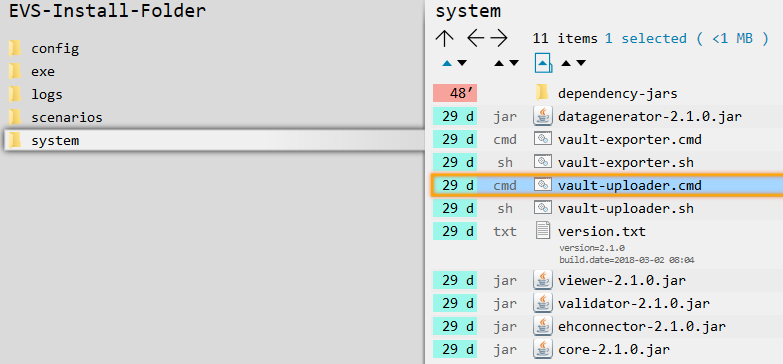...
| Table of Contents |
|---|
Introduction
EVS allows to manipulate the manipulation of vault contents using specific actors and specific patients, manually or based on previously exported vault contents.
...
This manual describes EVS v2.1.0.
Functionality
General
EVS EVS2 allows a certain actor to perform, for a certain patient, a number of actions.
These actions are triggered by dropping input files in (subfolders of) the input-folder:
EVS EVS2 watches these folder(s), executes the action(s) and generates output in the processed-folder:
EVS EVS2 can be launched via the "vault-uploader.cmd" batch file:
The behaviour of EVS EVS2 must be determined by passing some mandatory parameters. Instead of using the "vault-uploader.cmd" batch file, it is easier to use the example batch file "start EVS.cmd":
This batch file contains parameter values for a standard behaviour. How the parameters change the behaviour can be found in the paragraph EVS 2 EVS2 user manual.
Input-folder
Which patient?
...
Any type of files, with any extension, can be dropped. They are considered as "input-files". EVS EVS2 will, depending on the action folder, parse the files and extract the Kmehrmessage(s).
What is a Kmehrmessage?
...
A Kmehrmessage is that a part of the file that starts with <kmehrmessage ...> and ends with </kmehrmessage>. One file can contain 0 or more Kmehrmessages.
EVS EVS2 will only work with Kmehrmessages of Kmehr-standard 20120401 and Kmehr-standard 20161201. It will automatically convert Kmehrmessages of Kmehr--20120401. In this standard, 1 medicationschemeelement transaction and 0 or more treatmentsuspension transactions were considered as the business data of 1 "data entry"standard 20120401 to Kmehr-standard 20160401.
All other data (among which the metadata) will be generated by the EVS and/or the Vitalink platform. As input the business data as depicted in blue here below will be used:
...
| Path | Reserved path | Reserved name | Explanation | ||||||
|---|---|---|---|---|---|---|---|---|---|
| EVS | The root folder. The name and location can be freely chosen. Keep in mind that paths used in scenarios, patient and actor files are possibly impacted by changes to this! | ||||||||
| \config | Everything that defines the behaviour of EVS, configured as needed by the user. | |||||||
| \actors | All the actors that can be used by EVS. | ||||||||
| \log4j | Settings of the log4j library. Please refer to https://logging.apache.org/log4j/2.x/manual/configuration.html for more explanation. | ||||||||
| \patients | All the patients that can be used by EVS. | ||||||||
| \exe | |||||||||
| \certificates | The certificates used in the actor configuration files. | ||||||||
| \exports | The folder were the EVS-exporter will put exported vault contents, see EVS 2 EVS2 user manual | ||||||||
| \interaction | |||||||||
| \input | |||||||||
| \katrien | |||||||||
| \gp_van_gucht | |||||||||
| \add | |||||||||
| \empty | |||||||||
| \export | |||||||||
| \removeID | |||||||||
| \removeREF | |||||||||
| \replace | |||||||||
| \updateID | |||||||||
| \updateREF | |||||||||
| \generateREF | |||||||||
| \updateschemeREF | |||||||||
| \patient_template | |||||||||
| \processed | |||||||||
\scenarios | |||||||||
| \basic_example | |||||||||
| \system | |||||||||
| \dependency-jars | |||||||||
...





